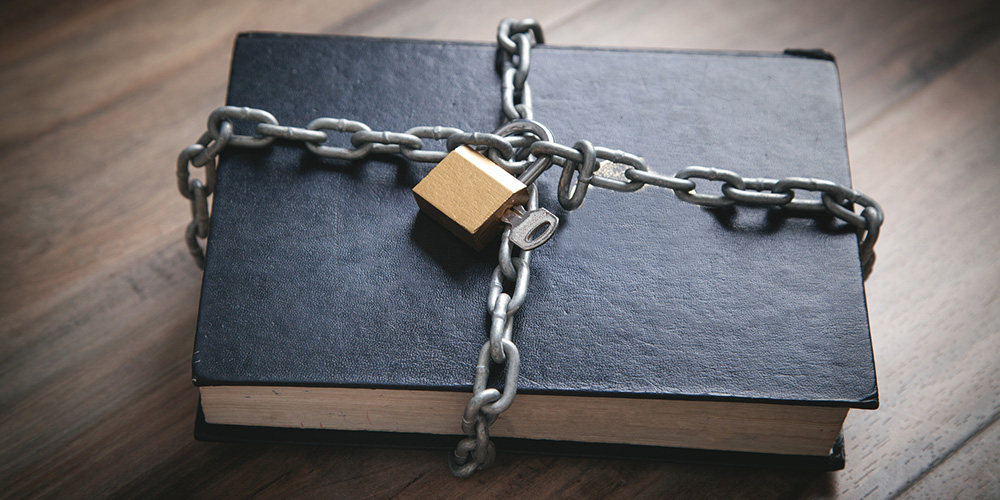Why teach banned books? We have a truckload of reasons.
Learning means critical thinking. Learning means communication, problem-solving, and self-expression. It means tapping into the imagination and wonder that might just lead to a brilliant career. And, according to the most precious objective of all, learning means empathy for humankind — all of it, the entire mega-complicated jumble of us.
Reaching this destination requires reading, no question. But if you stroll through the gallery of banned books, it becomes clear some people who wield power feel different about our mission as educators.
Sadly, the list of banned books stretches on and on. The catalogue of blacklisted literature runs so long, in part, because it’s not some hysterical practice that ended decades ago. Books from every generation vanish from the curriculum and public libraries without logic or goodwill. Lucky for us, teaching those banned books empowers students to discover why and how a voice gets silenced.
The Book Deemed Most Dangerous
If your last name becomes an adjective, you know you’ve made it as an author. No doubt George Orwell stands at the very top of this hill. To deem an idea or practice Orwellian calls out surveillance, government micro-management, controlling the thoughts of all people, and denying the right to individuality. Which pretty much sums up the central premise of 1984, Orwell’s novel about a totalitarian government that uses misinformation as the driving force behind its laws and policies.
In line with its themes, the novel earned a special spot in the literary world. Not only because it’s a page-turner. Not only because readers tap into a cautionary tale that encourages introspection and critical thought about our collective function as a society. The book gains honors as the most banned and challenged piece of literature in history. (We bet Mr. Orwell felt pretty darn proud of that gold medal.)
So, why does this book, published near the end of the Second World War, smack in the middle of the 20th century, cause such a moral panic? If you ask certain lawmakers and other book-banning advocates, the novel contains pro-communist messaging and obscene descriptions of sex.
To be clear, those 300-some-odd pages highlight the failings of Stalinist Russia. And the limited passages detailing sexual encounters read as subdued and matter-of-fact when compared to most other novels. Despite all that, 1984 gets tossed atop the burn pile over and over again. It all leads to the three pillars that the book’s authoritarian antagonists hold in the highest esteem.
“War is peace. Freedom is slavery. Ignorance is strength.”
Those three sentences found in this book provide the backbone for Orwell’s central themes. Who could have guessed those ideas, meant as a friendly warning, would become a self-fulfilling prophecy?
Either way, these ideas and questions provide ideal fodder for classroom discussion and debate. Moreover, students will tap into the importance of critical thinking, paying attention to the world around them, and civil engagement. If we’re honest, not too many learning objectives stand a chance of topping that.
Teaching Banned Books: An Abridged Timeline
William Shakespeare. James Baldwin. Margaret Atwood. Toni Morrison. Mark Twain. Harper Lee. Kurt Vonnegut. Zora Neale Hurston. John Steinbeck. Judy Blume. Salman Rushdie. Vladimir Nabokov. Alice Walker. Walt Whitman. Charles Darwin.
Do we need to continue rattling off banned book authors to get the point across?
Those famous names hardly scratch the surface of an already long and continuously growing list. And the sad fact remains that the practice of denying access to literature has existed throughout documented history. In fact, well over 2,000 years ago, circa 259–210 B.C., Chinese emperor Shih Huang Ti burned every book in his kingdom. In that fit of megalomania, he hoped destroying all records and accounts meant history would begin with his tyrannical story.
For brevity’s sake, we’ll begin our timeline in the 18th century, with a semi-famous playwright from Stratford-Upon-Avon.
1788: William Shakespeare’s play King Lear got pulled from every stage, and audiences wouldn’t see a single performance until 1820. Naysayers cited disrespect toward King George III, whom historians remember for his instability.
1859: Charles Darwin’s book On the Origin of Species, which chronicled scientific facts and theories about evolution, got pulled from several libraries. All throughout the U.S., even today, Darwin’s chronicles have been classified as curricular contraband, with some states illegalizing the teaching of the author’s work.
1881: Walt Whitman’s Leaves of Grass, a book of poems about the trials and tribulations of living and working in America, found itself in the crosshairs of censorship. The district attorney’s office demanded the removal of passages they deemed inappropriate. However, their efforts prompted enough sales that the poet purchased a home from the proceeds.
1885: Mark Twain’s Huckleberry Finn got chucked from a number of libraries. Committees deemed the titular hero a posterchild for disobedient children.
1929: Sir Arthur Conan Doyle’s The Adventures of Sherlock Holmes got banned in Russia, as it supposedly contained elements of the occult.
1931: Lewis Carroll’s Alice in Wonderland found itself on the banned list in the Hunan province of China. The government found talking animals disturbing, as their ability to speak put them on an intellectual level with humans.
1959: Garth Williams’ The Rabbits’ Wedding, a children’s picture book, got pulled from library shelves in Alabama in light of how white citizens’ councils felt the author promoted racial desegregation.
1973: Kurt Vonnegut’s Slaughterhouse-Five burned in Drake, North Dakota. The school board cited references to homosexuality and swear words.
1977: Maurice Sendak’s In the Night Kitchen got removed from a school library in Illinois, as the book contained cartoon nudity.
1983: Anne Frank’s The Diary of a Young Girl got rejected by the Alabama State Textbook Committee. They deemed the book too depressing.
2019: Margaret Atwood’s The Handmaid’s Tale fell prey to a number of removal calls, most of them citing profanity, vulgarity, sex, and negative depictions of religion.
Most unfortunately, these case studies constitute a slivered fraction of banned titles. While some restricted books might fall outside your teacherly boundaries, rest assured all the ones that appear in this list come with academic and social merit.
Every aforementioned volume proves itself worthy of study and exploration, not only in what the passages contain, but also in what the stories mean in a broader context. In other words, stories mirror our lives, in some form or another, and that fact rings especially true for your students.
Source: Bannings and Burnings in History
Why Books Hit the Blacklist
Truth be told, most challenges occur at the local level, as the first amendment makes it quite difficult to erase a book from existence nationwide. Moreover, there is no question parents hold the right to control the media their children consume.
So, why bother?
Because often, the books that are banned have a lot more to say than just their objectionable content. In fact, the things people find offensive may be a minor part of the work as a whole, or a mere literary device used to discuss greater truths that could benefit the next generation.
That’s why it’s helpful to understand the common reasons books are banned; only then will educators be able to intelligently debate the relative merits of including them in a curriculum. According to the American Library Association, the call to banish books happens in light of the following, presented without context or speculation.
- 92.5% of cases brought against books cite some form of sexual content as cause for censorship.
- 61.5% of cases point to offensive language as the chief culprit.
- 49% of cases deem the content unsuitable for a particular age group.
- 26% of cases take exception to a religious viewpoint expressed in the book.
- 23.5% of cases call out LGBTQ content as a societal ill.
- 19% of cases say a book merits removal due to violence.
- 16.5% of cases claim a book includes elements of racism.
- 12.5% of cases object to depictions of drugs or other illegal substances.
- 7% of cases mention a book contains “anti-family” content.
- 6.5% of cases take issue with a perceived political viewpoint.
Where do we start? Truthfully, these objections lead to more questions than answers. To begin, we’re not quite sure how to pinpoint the meaning of “anti-family.” In fact, most all of these objections represent nebulous circumstances that differ wildly from one situation to another. How much overlap exists between LGBTQ, sexual content, and age inappropriateness? What actions constitute violence? What’s more, if we want kids to steer clear of illicit substances, should they not know what those are?
The lack of concrete terms points to the importance of nuanced discussions around this issue. Each book must be considered individually, lest ignorance or bigotry dismiss an otherwise worthy addition to the reading list. Ironically, our frequent inability to have such rational debates about literature represents exactly why kids need a great ELA education — and sometimes that means reading tough stuff!






